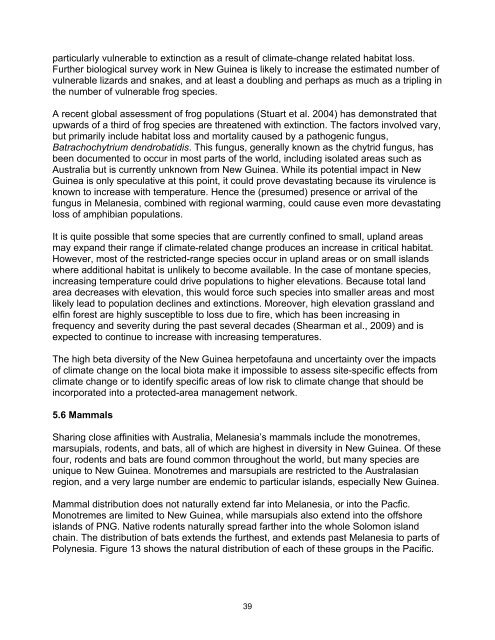What do we know? - Climate Adaptation Knowledge Exchange
What do we know? - Climate Adaptation Knowledge Exchange
What do we know? - Climate Adaptation Knowledge Exchange
- No tags were found...
Create successful ePaper yourself
Turn your PDF publications into a flip-book with our unique Google optimized e-Paper software.
particularly vulnerable to extinction as a result of climate-change related habitat loss.Further biological survey work in New Guinea is likely to increase the estimated number ofvulnerable lizards and snakes, and at least a <strong>do</strong>ubling and perhaps as much as a tripling inthe number of vulnerable frog species.A recent global assessment of frog populations (Stuart et al. 2004) has demonstrated thatupwards of a third of frog species are threatened with extinction. The factors involved vary,but primarily include habitat loss and mortality caused by a pathogenic fungus,Batrachochytrium dendrobatidis. This fungus, generally <strong>know</strong>n as the chytrid fungus, hasbeen <strong>do</strong>cumented to occur in most parts of the world, including isolated areas such asAustralia but is currently un<strong>know</strong>n from New Guinea. While its potential impact in NewGuinea is only speculative at this point, it could prove devastating because its virulence is<strong>know</strong>n to increase with temperature. Hence the (presumed) presence or arrival of thefungus in Melanesia, combined with regional warming, could cause even more devastatingloss of amphibian populations.It is quite possible that some species that are currently confined to small, upland areasmay expand their range if climate-related change produces an increase in critical habitat.Ho<strong>we</strong>ver, most of the restricted-range species occur in upland areas or on small islandswhere additional habitat is unlikely to become available. In the case of montane species,increasing temperature could drive populations to higher elevations. Because total landarea decreases with elevation, this would force such species into smaller areas and mostlikely lead to population declines and extinctions. Moreover, high elevation grassland andelfin forest are highly susceptible to loss due to fire, which has been increasing infrequency and severity during the past several decades (Shearman et al., 2009) and isexpected to continue to increase with increasing temperatures.The high beta diversity of the New Guinea herpetofauna and uncertainty over the impactsof climate change on the local biota make it impossible to assess site-specific effects fromclimate change or to identify specific areas of low risk to climate change that should beincorporated into a protected-area management network.5.6 MammalsSharing close affinities with Australia, Melanesia’s mammals include the monotremes,marsupials, rodents, and bats, all of which are highest in diversity in New Guinea. Of thesefour, rodents and bats are found common throughout the world, but many species areunique to New Guinea. Monotremes and marsupials are restricted to the Australasianregion, and a very large number are endemic to particular islands, especially New Guinea.Mammal distribution <strong>do</strong>es not naturally extend far into Melanesia, or into the Pacfic.Monotremes are limited to New Guinea, while marsupials also extend into the offshoreislands of PNG. Native rodents naturally spread farther into the whole Solomon islandchain. The distribution of bats extends the furthest, and extends past Melanesia to parts ofPolynesia. Figure 13 shows the natural distribution of each of these groups in the Pacific.39
















